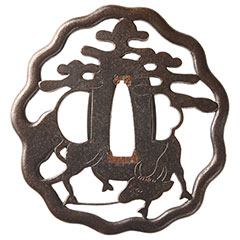
特別保存刀装具Tokubetsuhozon Tousougu
林重光 松樹繁牛透鍔/鐔 Hayashi Shigemitsu Syouju Tsunagi Ushi Sukashi Tsuba
No.372288重光 松樹繁牛透鍔Shigemitsu Syouju Tsunagi Ushi Sukashi Tsuba
- 極めKiwame
- 重光Shigemitsu
- 時代Period
- 江戸時代Edo period
- 法量Size
-
縦 7.87cm 横 7.44cm 切羽台 0.49cm 中心孔縦 2.06cm 中心孔横 0.78cm 重量 100.0g
Length 7.87cm Width 7.44cm Seppadai 0.49cm Nakaoana-Length 2.06cm Nakaoana-Width 0.78cm Weight 100.0g
- 説明Drscription
- 変り形 鉄地 地透毛彫 丸耳
重光は又七の長男として1667年肥後に生まれる。同家の二代として父に次ぐ力量を認められる。細川家の藩工で優工である。1744年78歳で没した。
林一派は同国飽田郡春日村に住したので春日派ともいわれ,平田,西垣,志水の3家とともに肥後金工の四大派を形成した。
肥後熊本藩主、細川忠利に抱えられ,鐔工に転じて肥後鐔を完成した。林家はその主流をなし,とくに又七は肥後金工の祖といわれている。又七の作風は,鉄鍔の製作を得意とし、鉄の鍛が抜群によく 鉄錆のよさに加えて金象眼の巧みさと精巧な透しに特色がある。重要文化財の「破扇(はせん)桜象眼鐔」「桜九曜文透象眼鐔」をはじめ、遠見松透、投桐(なげぎり)透、御紋透などがある。林家の家系は、又七を初代にとし、二代藤平(重光)三代藤八重房 四代平蔵重次五代又平勝家(家久)六代又八 七代藤七と継承して幕末期まで繁昌した。 Kawarigata Tetsuji Jisukashikebori Marumimi
Shigemitsu was born in Higo in 1667 as Matashichi's eldest son. As the second generation of the family, he was recognized as a skilled craftsman second only to his father. He was an excellent craftsman of the Hosokawa clan. He died in 1744 at the age of 78.
He was employed by Tadatoshi Hosokawa, the lord of the Higo Kumamoto Domain, and became a tsuba maker, completing Higo tsuba.
He was employed by Tadatoshi Hosokawa, the lord of the Higo Kumamoto Domain, and became a tsuba maker, completing Higo tsuba. The Hayashi family is the mainstream, and Matashichi in particular is said to be the founder of Higo metalwork.
Matashichi's style was characterized by the production of Tetsu(Iron)-tsuba, which was excellent in Tetsu(Iron)-Kitae, excellent rust resistance, and skillful Kinzougan(gold inlay )and Sukashi openwork.
Their tsuba include the "Hasen Sakura Zougan(Inlaid) Tsuba" and "Sakura Kuyoumon Sukashi Zougan(Inlaid) Tsuba" from Juyo-Bunkazai, as well as the TohmiMatsu Sukashi, Nagegiri Sukashi, and Gomon Sukashi.
The Hayashi family lineage began with Matashichi, and was succeeded by the second Fujihira (Shigemitsu), the third Fujiyaefusa, the fourth Heizo Shigetsugu the fifth Matahira Katsuie (Iehisa), the sixth Matahachi, and the seventh Fujishichi, prospering until the end of the Edo period.


